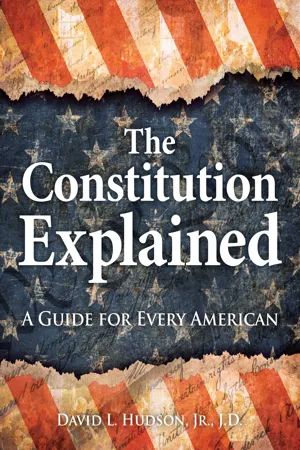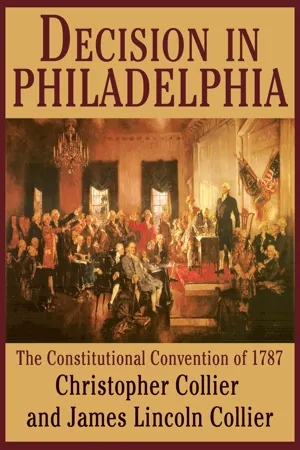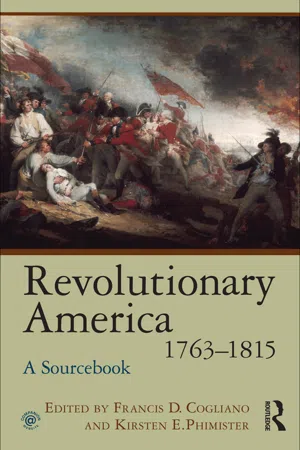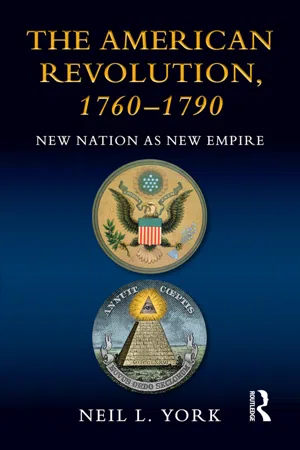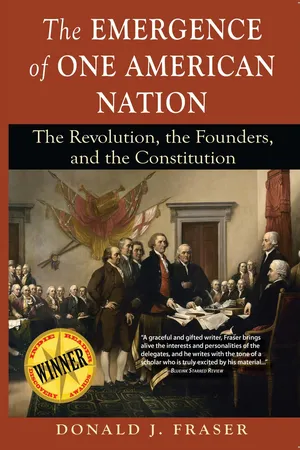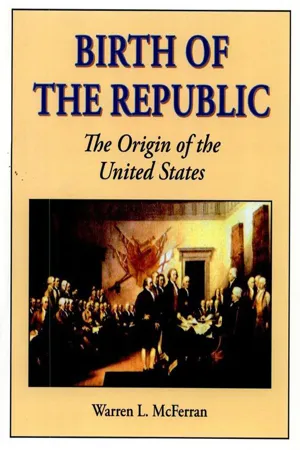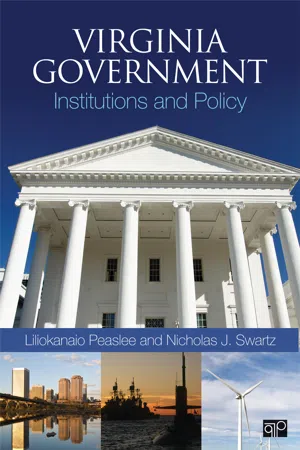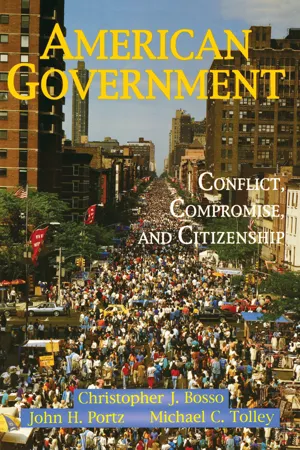Politics & International Relations
Virginia Plan
The Virginia Plan was a proposal for a new national government put forward during the Constitutional Convention of 1787. It called for a strong central government with three branches and a bicameral legislature, with representation based on population. This plan ultimately influenced the structure of the United States government as outlined in the Constitution.
Written by Perlego with AI-assistance
Related key terms
9 Key excerpts on "Virginia Plan"
- eBook - ePub
The Constitution Explained
A Guide for Every American
- David L. Hudson(Author)
- 2022(Publication Date)
- Visible Ink Press(Publisher)
The Pinckney and Hamilton plans were minor compared to the influential Randolph and Paterson plans. The Randolph plan favored a stronger central government, while the Paterson plan favored a weaker central government.Virginia Plan/Randolph Plan
The Virginia Plan, introduced on May 29, 1787, formed the basis of the Convention and was debated word by word. The plan contained 15 resolves. It was the first plan introduced in the Convention and the one that most closely resembled the Convention’s final product.Drafted by James Madison, the Virginia Plan proposed the Constitutional Convention be held to establish a central government with a bicameral system and three branches of government.It proposed that the powers of the federal government should be expanded to accomplish three goals: “common defence, security of liberty and general welfare. Resolve number three provided for two houses of the Congress, or a bicameral legislature. Under the Virginia Plan, the people would elect the first branch. Then, the members of the first branch would elect the second branch of the “National Legislature.”Under the Virginia Plan, the U.S. Congress would possess great power. Resolve number six granted Congress the power to negate, or veto, any laws passed by state legislatures. Resolve number seven provided Congress with the power to appoint the “National Executive,” or leader of the country. Thus, under this plan, Congress, not the people, would select the national leader. Resolve number nine provided for a “National Judiciary,” or a set of judges that could hear cases throughout the country.Pinckney Plan
Charles Pinckney (1757–1824) of South Carolina introduced a plan of government on the same day as the Virginia, or Randolph, Plan. The plan was similar in some respects to Madison’s ideas. In fact, some historians suspect that Madison gave little mention to Pinckney’s plans in his notes because he did not want the Pinckney Plan to receive credit.Pinckney’s plan also argued for a strong national government. The Convention as a whole never debated Pinckney’s plan. However, it was referred to a later committee, the Committee of Detail, which made use of it. Christopher and James Lincoln Collier write: “Many of Pinckney’s ideas, and even his language, ended up in the final Constitution of the United States.” - eBook - ePub
The Constitution's Penman
Gouverneur Morris and the Creation of America's Basic Charter
- Dennis C. Rasmussen(Author)
- 2023(Publication Date)
- University Press of Kansas(Publisher)
19 Once he agreed to attend the Convention, however, Morris resolved to fight for the centralized power that he had envisioned since the outset of the Revolution._________The fifteen-point Virginia Plan that Morris and Wilson helped Madison and the rest of the Virginia delegation devise prior to the Convention’s official opening was not to his liking in every respect, judging from his interventions later in the summer. To take just one glaring example, the plan specified that the executive would be elected by the national legislature, which is an arrangement that Morris went on to fight as vehemently and persistently as anything at the Convention.20 On the most basic level, however, the Virginia Plan did exactly what Morris thought necessary: it replaced the Confederation Congress and its subservience to the state legislatures with a true, fully empowered, three-branch national government. The fact that this plan ended up serving as the starting point for the Convention’s deliberations represented a coup of sorts for the more national-minded delegates, for it established at the outset that they would not limit themselves to proposing amendments to the Articles of Confederation, as they had been charged with doing, but would instead forge an entirely new charter. (One historian has called the lack of a quorum at the Convention’s scheduled opening “the delay that produced a revolution.”)21As it was presented by Edmund Randolph on May 29 , the Virginia Plan’s first resolution was somewhat disingenuous. It held that “the Articles of Confederation ought to be so corrected and enlarged as to accomplish the objects proposed by their institution; namely, ‘common defence, security of liberty, and general welfare’”—yet the succeeding fourteen resolutions did not correct and enlarge the Articles so much as entirely replace them.22 When the debate on the plan opened on May 30 , Morris immediately sought to clear up the ambiguity, suggesting that the first resolution was dubious “as the subsequent resolutions would not agree with it.”23 - eBook - ePub
Decision in Philadelphia
The Constitutional Convention of 1787
- Christopher Collier, James Lincoln Collier(Authors)
- 2012(Publication Date)
- Blackstone Publishing(Publisher)
The conflict between the big states and the small ones was joined on May 29, with the presentation of the Virginia Plan, by the Virginia governor, the charming but frequently irresolute Edmund Randolph. The plan, as we have seen, called for a legislature based on proportional representation, which the small states were certain to hate.The Virginia Plan was debated by the Convention, sitting as the Committee of the Whole, from May 30 to June 13. To the immense consternation of the small states, it was passed with no basic changes. It went through so easily because the Virginians had put together an alliance of the three most populous states—Virginia, Pennsylvania, and Massachusetts—and the three states of what was then the Deep South—Georgia and the two Carolinas.The alliance was based in part on the misperception that with population flowing into the southwest, the Deep South states would soon be big states themselves; their interests would eventually be the same as those of the Big Three. The alliance may also have been based on a sense among the delegates from the Deep South that if they supported the Big Three on issues important to them, Virginia, Massachusetts, and Pennsylvania would not attempt to harass the Deep South on an issue crucial to them—slavery.Yet it was an uneasy alliance. Northerners and southerners were suspicious of each other, and their interests were opposed in a number of areas, as we shall eventually see. But for the moment the alliance held, and it was able to ram through proportional representation. But long before the ramming was done, it was clear to everybody that the Convention was faced with a deep division, which might shortly tear it apart. So strongly did men on both sides of the issue feel about it that other important issues could not be profitably addressed until this one was settled.Today it is difficult to see why the issue should have brought such smoking ferocity to the Convention floor. Rarely in the history of the United States have the small states and the large states lined up on opposite sides of an issue. Political divisions tend to be, for example, sectional, with the South poised against the North, or the Sun Belt at odds with the Frost Belt. Or they are cut along economic lines, with city dwellers fighting farmers over, say, farm subsidies. - eBook - ePub
Revolutionary America, 1763-1815
A Sourcebook
- Francis D. Cogliano, Kirsten E. Phimister(Authors)
- 2010(Publication Date)
- Routledge(Publisher)
The Virginia Plan (document 2) would strike at the authority of the states—both because it would vest so much authority in the federal government and because representation within the proposed bicameral congress would be apportioned according to population. Under the Continental Congress and the Articles of Confederation, each of the states were equal and possessed one vote. On June 14 and 15, 1787, William Paterson (1745–1806) of New Jersey presented an alternative to the Virginia Plan. According to Paterson’s plan, which had the support of several small states which feared they would be overwhelmed under the Virginia Plan,Congress would have increased powers but it would retain a unicameral structure and each state delegation would have one vote. Paterson’s plan was closer to the original intention of the Constitutional Convention in so far as it recommended modifications to the Articles of Confederation rather than their replacement by a new constitution. The New Jersey Plan prompted a debate about the nature of representation in the new government, and a compromise emerged whereby representation in the lower house of Congress, the House of Representatives, would be according to state population but each of the states would be equal in the upper house having two votes in the Senate.1. Resd. that the articles of Confederation ought to be so revised, corrected & enlarged, as to render the federal Constitution adequate to the exigencies of Government, & the preservation of the Union.2. Resd. that in addition to the powers vested in the U. States in Congress, by the present existing articles of Confederation, they be authorized to pass acts for raising a revenue, by levying a duty or duties on all goods or merchandizes of foreign growth or manufacture, imported into any part of the U. States, by Stamps on paper, vellum or parchment, and by a postage on all letters or packages passing through the general post-Office, to be applied to such federal purposes as they shall deem proper & expedient; to make rules & regulations for the collection thereof; and the same from time to time, to alter & amend in such manner as they shall think proper: to pass Acts for the regulation of trade & commerce as well with foreign nations as with each other: provided that all punishments, fines, forfeitures & penalties to be incurred for contravening such acts rules and regulations shall be adjudged by the Common law Judiciaries of the State in which any offense contrary to the true intent & meaning of such Acts rules & regulations shall have been committed or perpetrated, with liberty of commencing in the first instance all suits & prosecutions for that purpose in the superior Common law Judiciary in such State, subject nevertheless, for the correction of all errors, both in law & fact in rendering judgment, to an appeal to the Judiciary of the U. States. - eBook - ePub
The American Revolution
New Nation as New Empire
- Neil L. York(Author)
- 2016(Publication Date)
- Routledge(Publisher)
Delegates at the convention emulated the national congress and voted by state rather than as individuals. Unlike Congress, votes could carry by a simple majority rather than by two-thirds. That decision proved absolutely indispensable because some of the more crucial motions only carried by one vote, in five to four divisions. A split delegation resulted in an abstention. Those splits were quite common; rarely was there a vote where even ten delegations expressed a clear yea or nay.During the first week of deliberations, the Virginians introduced a plan to “correct and enlarge” the national government. That plan became the basis of discussions throughout the coming months and the new constitution that eventually emerged bore a notable resemblance to that proposal. It claimed to be improving, not replacing, the existing union, even though the governmental apparatus presiding over it would be greatly altered. Much of the proposal had deliberately been left vague. The full convention was expected to fill in the spaces left blank.The Virginians called for a bigger and more vigorous national government, with a separate executive and judiciary. Congress would be expanded to have two houses rather than just the one provided for under the Articles. Members of the lower house would be elected by the people of the states. Members of that lower house would elect members of the upper house, choosing from nominees submitted by each respective state legislature. Representation in both houses would be proportional. Voting would be by individual in both houses rather than by state delegation, as had been the practice under the Articles.The details of the executive office—whether it would be composed of one individual or more than one—were not specified; likewise for the number of judges and courts in the new national judiciary. Nor did the Virginians specify how much authority to legislate the new congress would have in contrast to the old. Explicitly, it would have at least as much; implicitly, every delegate at the convention knew it would have to have more to make any difference. But how much more? That was a key question, demanding some sort of answer. - eBook - ePub
The Emergence of One American Nation
The Revolution, the Founders, and the Constitution
- Donald J Fraser(Author)
- 0(Publication Date)
- Fraser & Associates(Publisher)
Such a proposal, if combined with the direct election of the House based on proportional representation, would mean that the large states would dominate both chambers of the legislature. Richard Spaight of North Carolina, along with Sherman and Butler, proposed that the state legislatures should choose the members of the Senate. Wilson wanted the people to directly elect both the Senate and the House, “because the second branch…ought to be independent of both” the House and the state legislatures. They then put the original proposal as contained in the Virginia Plan to a vote and lost, with only three states voting yes. Madison had finally lost a major vote, causing him to remark that, “A chasm [was] left in this part of the plan.” 57 On May 31, the Framers debated one last major element of the Virginia Plan that dealt with whether the Congress would be provided with the power “to legislate in all cases to which the separate States are incompetent” and “to negative all laws passed by the several States” where such laws were found to be in violation of “the articles of Union.” 58 Several members protested that the language of the resolution, specifically the word “incompetent” was too vague. Both Randolph and Madison indicated they did not intend to give unlimited power to the national legislature, and that the new government would be one of enumerated and limited powers. This seemed to assuage the Convention members, and they approved the first part of the resolution on a vote of nine to zero, with Connecticut divided. Surprisingly, the proposal to allow the national legislature to veto state laws passed without debate and dissent, a decision that they would ultimately overturn later in the Convention. They decided to postpone a final element of the sixth resolve, which would have allowed for the use of force against a delinquent state, when Madison indicated he was having second thoughts about such an approach - eBook - ePub
Birth of the Republic
The Origin of the United States
- Warren L. McFerran(Author)
- 2009(Publication Date)
- Pelican Publishing(Publisher)
As long as it appeared that the Virginia Plan could be carried, he kept his own plan under cover and allowed the other key nationalists - James Madison and James Wilson - to parry blows with the Federal Republicans. "On the rare occasions when Hamilton took the floor," wrote Mr. Miller, "it was usually in order to amend the Virginia Plan in the direction of greater cen tralization of authority and more power in the Presidency." [Emphasis added] 18 When James Wilson moved on June 4th, for example, that the Chief Executive should have an absolute veto over legislative acts, Alexander Hamilton heartily seconded the motion, arguing that there would be little danger of abusing such a sweeping power. But when the Convention finally voted on the proposal, only Mr. Hamilton, Mr. Wilson, and Gouverneur Morris were found to favor such broad authority for the President of the United States. With the introduction of the New Jersey Plan by the Federal Republicans, the fiery nationalist from New York was aghast. The only thing worse than a proposal that the Convention seriously consider the retention of the Federal Republic, in his view, was the very real possibility that the Convention might just decide to retain the federal system. The time had come, he was convinced, to unveil his own plan of government. According to Mr. Hamilton's biographer: Although Hamilton spoke on June 18 with such magisterial and provocative assurance that some delegates felt that no young man had a right to imagine himself to be as right as Hamilton obviously did, his oratorical effort was generally well received - eBook - ePub
Virginia Government
Institutions and Policy
- Liliokanaio Peaslee, Nicholas J. Swartz(Authors)
- 2013(Publication Date)
- CQ Press(Publisher)
Virginia’s constitution was the first of the thirteen state constitutions to be adopted, and the document was widely influential in both the United States and abroad. In fact, some of the key framers of the Virginia Constitution would go on to strongly influence the U.S. Constitution. Thomas Jefferson was also Virginia’s representative at the Second Continental Congress, and his drafts of the Virginia Constitution strongly influenced his work on the U.S. Declaration of Independence. James Madison, another framer, used his work on the Virginia Constitution to help develop ideas and skills that he would later use as one of the primary architects of the U.S. Constitution. The 1776 constitution established the Virginia General Assembly to oversee legislative matters. The bicameral system housed a legislature divided into two separate houses—the House of Delegates and a Senate. The House of Delegates comprised two representatives from every state county plus one representative from the cities of Williamsburg and Norfolk who were elected on an annual basis. The Senate comprised twenty-four members who were elected on staggered terms so that six senators were up for election each year. Seeking to create balance, the Virginia Constitution also established an executive and judicial branch in addition to the legislative branch, proclaiming that the legislative, executive, and judicial branches should be separate and distinct and that neither could exercise the powers that were assigned to the others. While the framers sought to establish a balance of powers, the legislature ultimately controlled a majority of the power. Individuals at the time were extremely wary of executive power because of King George III and therefore wanting to limit the power of the executive, while granting certain powers more directly in the hands of the people. The governor’s office was only a one-year term, and he was nominated by the General Assembly - eBook - ePub
American Government
Conflict, Compromise, And Citizenship
- Christopher J Bosso, John Portz, Michael Tolley(Authors)
- 2018(Publication Date)
- Routledge(Publisher)
The provision for a separate executive, which did not exist under the Articles, certainly had administrative efficiency in mind, but it also reflected the framers’ concern that legislative and executive powers should not rest with the same institution. Just as no one person should act as judge, jury, and executioner, no single institution should be able to make, implement, and interpret the law. To allow for such a concentration of power was to invite tyranny. S EPARATE C ONSTITUENCIES Separation of powers would not, however, prevent the abuse of power if one branch were allowed to select members of the others. The drafters of the Virginia Plan had such an idea in mind in their proposal that an elected lower chamber would actually approve the members of the other chamber. Delegates representing the less-populous states opposed the idea precisely because it gave so much power to the majority. This fear, along with concern about ensuring adequate representation for as many different parts of society as possible, led the framers to design means of selection and terms of office in ways that they hoped would foster democratic accountability. As a result, American national government is a collection of separate institutions, each representing distinct and only partly overlapping groups of citizens (or “constituencies”), with none having total power. House of Representatives The impacts of these arrangements are best seen in Congress, where the House and Senate embody distinct notions about representation and were meant to represent different constituencies. The House of Representatives was designed to represent the majority of the people, wherever they lived. Article I, Section 2 of the Constitution specifies that the number of representatives per state will be based on that state’s population and that there should be one representative for every 30,000 people, with each state having at least one representative
Index pages curate the most relevant extracts from our library of academic textbooks. They’ve been created using an in-house natural language model (NLM), each adding context and meaning to key research topics.
